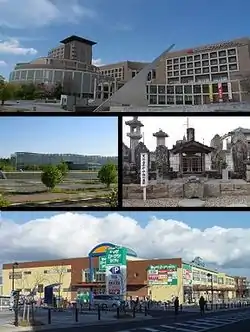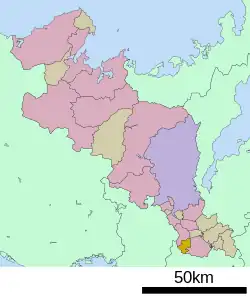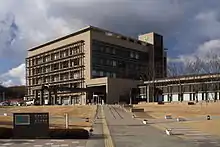Seika
精華町 | |
|---|---|
 | |
 Flag  Chapter | |
Location of Seika in Kyoto Prefecture | |
 | |
 Seika Location in Japan | |
| Coordinates: 34°45′39″N 135°47′09″E / 34.76083°N 135.78583°E | |
| Country | Japan |
| Region | Kansai |
| Prefecture | Kyoto |
| District | Sōraku |
| Government | |
| • Mayor | Masami Sugiura |
| Area | |
| • Total | 25.68 km2 (9.92 sq mi) |
| Population (September 1, 2023) | |
| • Total | 36,542 |
| • Density | 1,400/km2 (3,700/sq mi) |
| Time zone | UTC+09:00 (JST) |
| City hall address | 70 Kitajiri Minamiinayazuma, Seika-chō, Sōraku-gun, Kyōto-fu 619-0285 |
| Website | www-e |
| Symbols | |
| Flower | Rose |
| Tree | Live oak |

Seika (精華町, Seika-chō) is a town located in Sōraku District, Kyoto Prefecture, Japan. As of 1 September 2023 the town has an estimated population of 36,542 in 15468 households and a population density of 1400 persons per km².[1] The total area of the town is 25.68 square kilometres (9.92 sq mi).
Geography
Seika is located at the extreme southwestern tip of Kyoto Prefecture, bordered by the Kizu River to the east and the Keihanna Hills to the west. Due to its position adjacent to the Kizu River, the eastern part of Seika has rich, fertile land ideal for agricultural production. The hilly western and southern parts of Seika, by contrast, are largely residential. Seika's largest peak is Dakeyama (嶽山), at 259.5 meters. It is located on the west side of Seika near the border of Kyotanabe city.
Neighboring municipalities
Neighborhoods
- Inuidani (乾谷)
- Ueda (植田)
- Kita-inayazuma (北稲八妻)
- Sakuragaoka (桜が丘)
- Zakuro (柘榴)
- Shimokoma (下狛)
- Sugai (菅井)
- Seikadai (精華台)
- Hikaridai (光台)
- Higashibata (東畑)
- Hishida (菱田)
- Housono (祝園)
- Housono-nishi (祝園西)
- Minami-inayazuma (南稲八妻)
- Yamada (山田)
Climate
Seika has a humid subtropical climate (Köppen Cfa) characterized by warm summers and cool winters with light to no snowfall. The average annual temperature in Seika is 14.3 °C. The average annual rainfall is 1356 mm with September as the wettest month. The temperatures are highest on average in August, at around 26.3 °C, and lowest in January, at around 2.8 °C.[2]
Demographics
Per Japanese census data,[3] the population of Seika has increased in recent decades.
| Year | Pop. | ±% |
|---|---|---|
| 1940 | 8,165 | — |
| 1950 | 9,490 | +16.2% |
| 1960 | 9,373 | −1.2% |
| 1970 | 10,929 | +16.6% |
| 1980 | 15,334 | +40.3% |
| 1990 | 17,519 | +14.2% |
| 2000 | 26,357 | +50.4% |
| 2010 | 35,633 | +35.2% |
| 2020 | 36,198 | +1.6% |
History
The area of Seika was part of ancient Yamashiro Province. Archaeological records indicate that people have inhabited modern-day Seika since at least the Yayoi period. Seika is home to Inayazuma Castle, where part of the Yamashiro Riots of 1485 took place. The area around Seika has historically been considered a cultural corridor between the two ancient capitals of Kyoto and Nara. The villages of Komada, Hosono and Inada were established on April 1, 1889 with the creation of the modern municipalities system. These three villages merged on October 10, 1931 to form the village of Kawanishi. On April 1, 1951, Kawanishi merged with the village of Yamadaso to form the village of Seika. Seika was elevated to town status on April 1, 1955.
Beginning in the 1960s, Seika has experienced rapid growth as commuters to Kyoto, Osaka and Nara move into the town. The town's population tripled in the span of 35 years, growing from 10,929 people in 1970 to 34,236 people in 2005. According to the 2005 census, Seika is the fastest-growing municipality in Japan.
Government
Seika has a mayor-council form of government with a directly elected mayor and a unicameral town council of 21 members. Seika, collectively with the other municipalities of Sōraku District and the city of Kizugawa, contributes two members to the Kyoto Prefectural Assembly. In terms of national politics, the town is part of the Kyoto 6th district of the lower house of the Diet of Japan.
Economy
Seika has a mixed economy. Although largely agriculturally based, has in recent years become the center of a national project, the Kansai Science City, and has been referred to as the "New Culture Capital" of Japan. Nippon Telegraph and Telephone Corporation (NTT), Matsushita Electric, Kyocera and many other companies have facilities in the town.The town is home to the Kansai-kan of the National Diet Library.
Agriculture
While strawberries are Seika's most famous product, the town is also known for its shrimp taro and green chili peppers.
Industry
The presence of the Kansai Science City makes research and technology core components of Seika's economy. Currently the following companies have facilities in Seika:
Locally Based Companies
In addition to the companies with facilities in Seika, companies headquartered in Seika include:
Education
Postsecondary
- Kyoto Prefectural University, Seika Campus
Primary and secondary
Seika has five public elementary school and three public junior high schools operated by the town government and one private high school. The prefecture operates one special education school for the handicapped.
- Seikadai Elementary School
- Higashihikari Elementary School
- Yamadasho Elementary school
- Kawanishi Elementary School
- Seihoku Elementary School
- Seika Junior High School
- Seika Nishi Junior High School
- Seika Minami Junior High School
- Kyoto Kōgakkan High School
- Minamiyamashiro Special Education High School
Transportation
Railways
![]() JR West - Katamachi Line (Gakkentoshi Line)
JR West - Katamachi Line (Gakkentoshi Line)
- Komada - Shin-Hōsono - <Kizugawadai> - Yamadagawa
Highways
International relations
Twin towns – Sister cities
Seika is twinned with:
Local attractions
Seika is home to Keihanna Plaza, a large building in the Kansai Science City boasting an auditorium and other facilities, as well as a large sundial known for projecting lasers into the sky at night. Keihanna Commemorative Park, which includes a large botanical garden, can also be found in the town. Additionally, the Kansai branch of the Diet Library is located in Seika.
Seika is home to several large festivals held annually. The Strawberry Hunt Festival is famous and has many visitors. Another well-known event is the Igomori Festival, which dates back to 770 A.D. and features a large, blazing torch being carried through the darkness of the night. Seika's main event is the Seika Festival, a large fair held every November featuring a large variety of different booths and performances, among other attractions.
Several notable temples and shrines are located in Seika. These include Hosono Shrine, where the Igomori Festival takes place, and Raiko-ji Temple, where the protagonists of Chikamatsu Monzaemon's play Love Suicides on the Eve of the Koshin Festival are buried.
Notable people from Seika
- Misato Watanabe, singer
References
- ↑ "Seika Town official statistics" (in Japanese). Japan.
- ↑ Seika climate: Average Temperature, weather by month
- ↑ Seika population statistics
- ↑ "Sister Cities". City of Norman. Retrieved 2012-01-07.
External links
 Media related to Seika, Kyoto at Wikimedia Commons
Media related to Seika, Kyoto at Wikimedia Commons Geographic data related to Seika, Kyoto at OpenStreetMap
Geographic data related to Seika, Kyoto at OpenStreetMap- Official website (in English)
- Official Kyoto Across Cultures Blog (in English and Japanese)